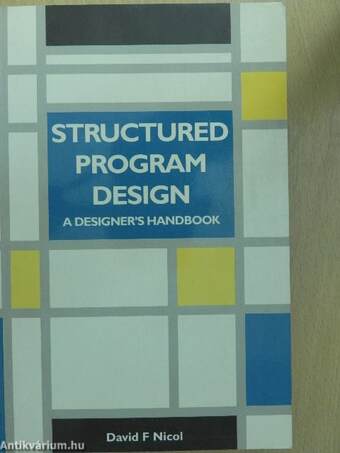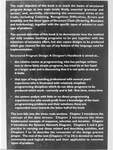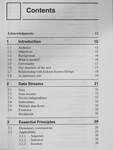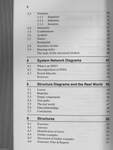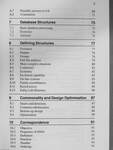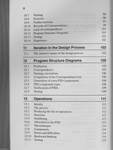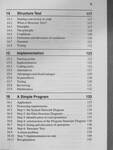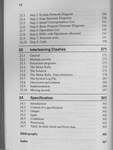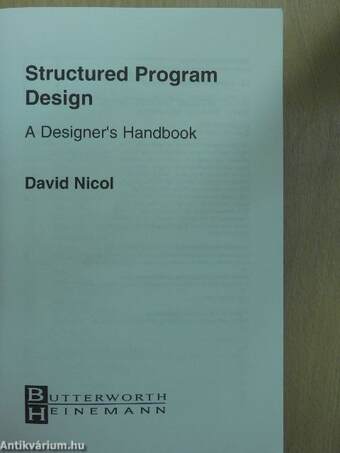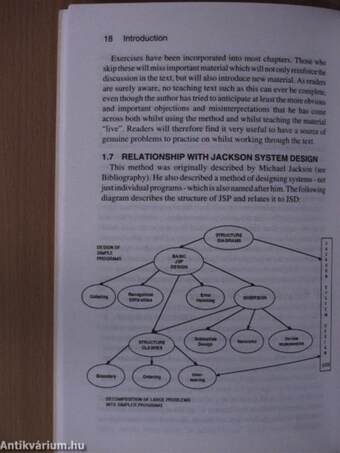1.067.317
kiadvánnyal nyújtjuk Magyarország legnagyobb antikvár könyv-kínálatát

VISSZA
A TETEJÉRE
JAVASLATOKÉszre-
vételek
Structured Program Design
A Designer's Handbook
| Kiadó: | Butterworth-Heinemann Ltd |
|---|---|
| Kiadás helye: | Oxford |
| Kiadás éve: | |
| Kötés típusa: | Fűzött papírkötés |
| Oldalszám: | 311 oldal |
| Sorozatcím: | |
| Kötetszám: | |
| Nyelv: | Angol |
| Méret: | 23 cm x 16 cm |
| ISBN: | 0-7506-1759-4 |
| Megjegyzés: | Fekete-fehér ábrákkal. |
naponta értesítjük a beérkező friss
kiadványokról
naponta értesítjük a beérkező friss
kiadványokról
Fülszöveg
The main objective of this book is to teach the basics of structured program design at two main levels; firstly, essential 'grammar and syntax', and, secondly, introducing the commonest tricks of the trade, including Collating, Recognition Difficulties, Errors and Invalidity and the three types of Structure Clash (Ordering, Boundary and Interleaving), together with the specific types of solution to each type of problem.
The second objective of this book is to demonstrate how the method not only enables working programs to be put together with the minimum of necessary effort, but alsó causes designs to be produced which give reasons for the use of any feature of the language used for implementation.
Structured Program Design: A Designer's Handbook is aimed at
• the relatíve novice at programming, who has perhaps written two or three fairly simple programs, has tried his or her hand at a larger scale and is discovering that it is not quite as easy as it looks
• that type of... Tovább
Fülszöveg
The main objective of this book is to teach the basics of structured program design at two main levels; firstly, essential 'grammar and syntax', and, secondly, introducing the commonest tricks of the trade, including Collating, Recognition Difficulties, Errors and Invalidity and the three types of Structure Clash (Ordering, Boundary and Interleaving), together with the specific types of solution to each type of problem.
The second objective of this book is to demonstrate how the method not only enables working programs to be put together with the minimum of necessary effort, but alsó causes designs to be produced which give reasons for the use of any feature of the language used for implementation.
Structured Program Design: A Designer's Handbook is aimed at
• the relatíve novice at programming, who has perhaps written two or three fairly simple programs, has tried his or her hand at a larger scale and is discovering that it is not quite as easy as it looks
• that type of long-standing professional with several years' experience who is frustrated with relatively simplistic programming disciplines which do not allow programs to be produced which work - correctly and in full - first time, every time
• the system analyst with little or no direct programming experience but who would profit from a knowledge of the basic programming problems and their solutions; these are expounded more towards the latter half of the book
The text falls into the three main sections. Chapter 2 introduces the concept of the data stream. Chapter 3 introduces the three fundamental concepts of sequence, selection and iteration. Chapter 4 introduces the Systems Network Diagram. Chapters 5 and 6 give practice in carrying out these related and describing activities, and Chapters 7 to 16 describe the remainder of the design process proper. The rest of the text (Chapters 17 to 24) is devoted to various commonly-used logical devices and their application to common types of problem. Vissza



